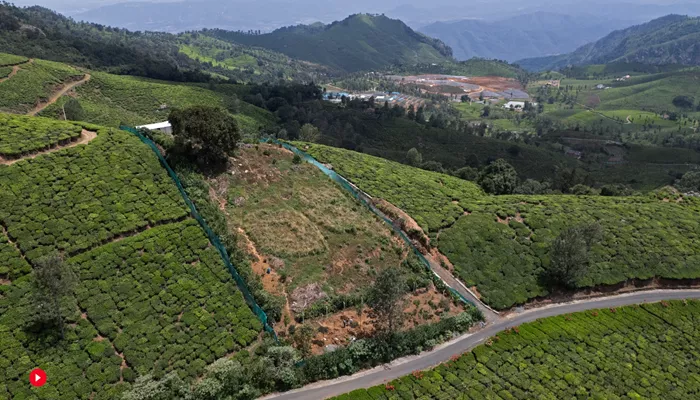UDHAGAMANDALAM, India (AP) — In southern India’s Nilgiris region, groves of native trees and occasional ancient burial grounds are nestled among the sprawling tea plantations that dominate the landscape. These sacred forests, once widespread across the Western Ghats mountains, have been reduced over the past 200 years, since British colonists established extensive tea farms. Today, these surviving groves are either protected by Indigenous communities or being restored by ecologists working to reverse the ecological damage caused by the plantations.
The restoration efforts, which involve clearing tea plants from abandoned farms and reintroducing native species, are gradually paying off. Despite the challenges of climate change and ecological degradation, these forests, which are home to over 600 plant species and 150 animal species found nowhere else, are slowly recovering.
“We are trying to help nature restore itself,” said Godwin Vasanth Bosco, a naturalist and restoration practitioner based in the Nilgiris. “In this time of climate change, ecological restoration is crucial.”
The Environmental Toll of Tea Plantations
Industrial-scale tea farming in the Nilgiris has taken a heavy toll on the environment. The vast tea estates have depleted the soil, and conflicts with wildlife, including elephants and Indian bison, have increased as animals lose their habitats.
Around 135,000 acres of tea plantations have replaced nearly 70% of the region’s native grasslands and forests. “There is no biological diversity,” said Gokul Halan, a water expert from Nilgiris. “These plantations don’t support local wildlife or provide food sources.”
Despite being recognized by the United Nations as one of the world’s most biodiverse areas, the tea farms are often referred to as “green deserts” due to the poor soil quality and lack of biodiversity. Furthermore, the region’s infrastructure is increasingly strained by growing tourism and population growth, which threatens to exacerbate environmental issues. The recent devastating landslides in nearby Wayanad, which killed nearly 200 people, highlight the risks that the Nilgiris also faces, including landslides, flooding, droughts, and heatwaves—all worsened by climate change.
Restoring the Forests and Bringing Life Back
In one mountain fold below the region’s highest peak, a restoration project is transforming former tea plantations back into thriving forests. Ten years ago, 7 acres of tea plants were replaced with native trees, and a stream that had once dried up year-round now flows constantly. “Since we began this work, the stream flows through the year, and the bamboo and trees have grown well,” Bosco said.
The restoration of these “Shola-grassland” or cloud forests is crucial, as they capture moisture from the high-altitude mist, supporting both plant and animal life. Bosco’s organization is working to restore nearly 2,000 acres, benefiting from the trees’ ability to retain moisture and nutrients in the soil, which helps other plants survive even in the region’s hot, dry summers.
Many Indigenous communities, known as Adivasi, have long viewed themselves as custodians of these forests. Some, like Mani Raman from the Alu Kurumbar community, see the restoration efforts as a way to revive their lost traditions. “When the British created tea estates, we were forced out, and our lands were taken from us,” Raman said. “Restoring the forests is important. It will bring back wildlife and give animals a place to live.”
Balancing Tea Production and Ecological Restoration
While environmentalists push for the return of native forests, local tea growers and factory owners emphasize that tea farming remains essential to the region’s economy. An estimated 600,000 people, including 50,000 small farmers, rely on tea for their livelihoods.
A. Balakrishnan, the owner of a tea factory in Kotagiri, argued that converting tea plantations back into forests could harm both the economy and the environment. “If tea is replaced with forests, Nilgiris would become a tourist destination, leading to more urbanization and construction,” he said.
I. Bhojan, a lifelong tea grower and president of a farmers’ association, agreed. “There is no Nilgiris without tea,” he said, highlighting the importance of the industry to the region’s identity and economy.
Agroforestry as a Solution
Experts suggest that agroforestry, which involves planting native trees and shrubs within tea estates, could provide a solution to the competing demands of agriculture and ecological restoration. By incorporating biodiversity into tea plantations, experts believe it is possible to create a more sustainable and balanced environment.
Tamil Nadu’s state government has already taken steps to support these efforts, including a $24 million initiative to reduce chemical fertilizers and promote soil health. Additionally, officials have announced plans to plant 60,000 native trees in the Nilgiris.
Restoration ecologist Bosco believes that promoting smaller, high-quality tea farming operations could free up more land for reforestation without harming farmers’ incomes. He also suggested that restoration efforts could be financially supported through the sale of products made from native plants, including medicinal herbs.
For Raman and other Indigenous leaders, these restoration projects hold deep cultural significance. “Adivasi people have been protecting forests for generations,” he said. “The government should take such efforts to a larger scale to ensure the preservation of these lands.”
As the Nilgiris moves forward, finding a balance between tea farming and ecological restoration remains a key challenge, but it is one that could help preserve both the region’s economy and its rich natural heritage for future generations.
Related topics:
- North Carolina Woman’s Okra Plant May Break World Record
- Foliage-Focused Plants That Delight with Unexpected Surprises
- Chilling Secret Behind the ‘Very Cool’ Plant Discovered in Aussie Woman’s Lawn


